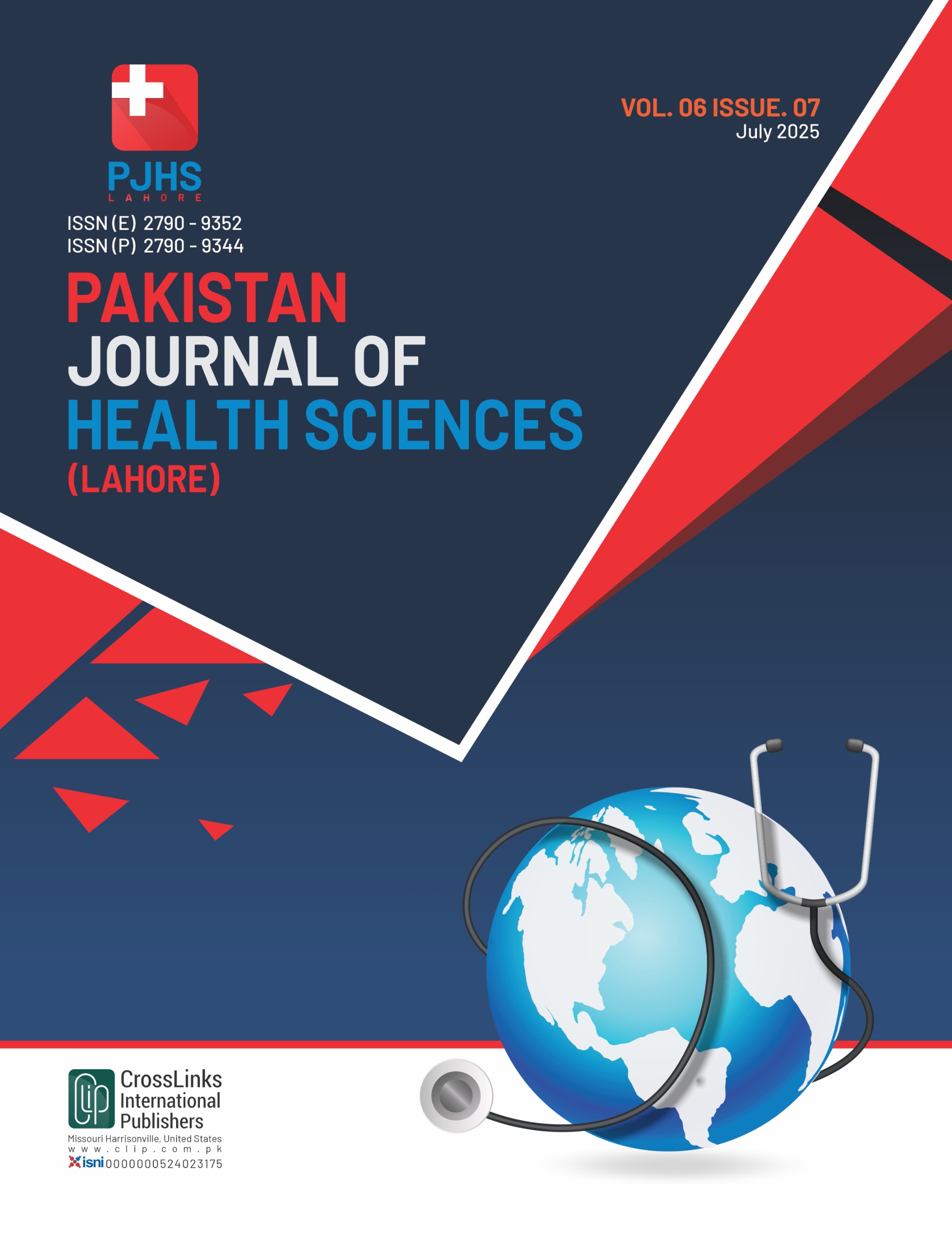Efficacy and Safety of Dapagliflozin Monotherapy in Patients with Insulin Resistance Syndrome and Relative Insulin Deficiency
Dapagliflozin in Insulin Resistance
DOI:
https://doi.org/10.54393/pjhs.v6i7.2992Keywords:
Dapagliflozin, Type 2 Diabetes Mellitus, Insulin Resistance Syndrome, Relative Insulin Deficiency, Glycemic ControlAbstract
Type 2 diabetes mellitus had different subtypes. Some patients had insulin resistance syndrome, while others had relative insulin deficiency. Dapagliflozin helped in both subtypes. It reduced blood sugar, weight, and improved heart health. It works with independent of insulin. Objective: To evaluate efficacy and safety of dapagliflozin monotherapy in patients with insulin resistance syndrome and relative insulin deficiency. Methods: This Prospective Quasi-Experimental Study Design was conducted at Bolan Medical College and Jhalawan Medical College Hospital between January 2024 and December 2024. A total of 180 T2DM patients (aged 30-70 years) received 10mg dapagliflozin monotherapy. Age, HbA1c, weight, glucose, and blood pressure were recorded at baseline and after three months. Patients were classified patho-physiologically as insulin resistance syndrome and relative insulin deficiency. Results: The most common age group was 41–50 years (65, 36.1%). The mean age was 54.3 ± 2 years. Males were 100 (55.6%) and females were 80 (44.4%). At baseline, HbA1c was 7.8 ± 0.5% and 8.3 ± 0.4%, glucose 158 ± 15.2 and 162 ± 14.5. At the 3-month follow-up, both groups showed reductions in HbA1c (−1.2 ± 0.4% in IRS vs. −1.0 ± 0.3% in RID), fasting plasma glucose (−22 ± 5.1 mg/dL vs. −18 ± 4.8 mg/dL), and body weight (−3.5 ± 1.0 kg vs. −2.2 ± 0.8 kg). Conclusion: Dapagliflozin improves glycemic control and weight control by reducing sugar in the urine in both insulin resistance syndrome and renal insufficiency disease patients.
References
Son O. Comparison of the effect of Dapagliflozin and Pioglitazone on the risk of osteoporosis in postmenopausal women with Type-2 diabetes. Pakistan Journal of Medical Sciences. 2023 Sep; 39(5): 1238. doi: 10.12669/pjms.39.5.7580. DOI: https://doi.org/10.12669/pjms.39.5.7580
Bhopal MP and Raghuwanshi A. Assessment of incidence of diabetic foot complications among patients with type 2 diabetes mellitus. Age (years). 2025 May; 59: 20-5. doi: 10.69605/ijlbpr_14.5.2025.199.
Su J, Luo Y, Hu S, Tang L, Ouyang S. Advances in research on type 2 diabetes mellitus targets and therapeutic agents. International Journal of Molecular Sciences. 2023 Aug; 24(17): 13381. doi: 10.3390/ijms241713381. DOI: https://doi.org/10.3390/ijms241713381
Lu X, Xie Q, Pan X, Zhang R, Zhang X, Peng G et al. Type 2 diabetes mellitus in adults: pathogenesis, prevention and therapy. Signal Transduction and Targeted Therapy. 2024 Oct; 9(1): 262. doi: 10.1038/s41392-024-01951-9. DOI: https://doi.org/10.1038/s41392-024-01951-9
Adnan M and Aasim M. Prevalence of type 2 diabetes mellitus in adult population of Pakistan: a meta-analysis of prospective cross-sectional surveys. Annals of Global Health. 2020 Jan; 86(1): 7. doi: 10.5334/aogh.2679. DOI: https://doi.org/10.5334/aogh.2679
American Diabetes Association Professional Practice Committee, American Diabetes Association Professional Practice Committee:. 9. Pharmacologic approaches to glycemic treatment: Standards of Medical Care in Diabetes-2022. Diabetes Care. 2022 Jan; 45(Supplement_1): S125-43. doi: 10.2337/dc22-S009. DOI: https://doi.org/10.2337/dc22-S009
Galindo RJ, Trujillo JM, Wang CC, McCoy RG. Advances in the management of type 2 diabetes in adults. British Medical Journal Medicine. 2023 Sep; 2(1): e000372. doi: 10.1136/bmjmed-2022-000372. DOI: https://doi.org/10.1136/bmjmed-2022-000372
Serbis A, Giapros V, Kotanidou EP, Galli-Tsinopoulou A, Siomou E. Diagnosis, treatment and prevention of type 2 diabetes mellitus in children and adolescents. World Journal of Diabetes. 2021 Apr; 12(4): 344. doi: 10.4239/wjd.v12.i4.344. DOI: https://doi.org/10.4239/wjd.v12.i4.344
Sharif H, Sheikh SS, Seemi T, Naeem H, Khan U, Jan SS. Metabolic syndrome and obesity among marginalised school-going adolescents in Karachi, Pakistan: a cross-sectional study. Lancet Reg Health Southeast Asia. 2024 Jan 30;21:100354. doi: 10.1016/j.lansea.2024.100354. PMID: 38322154; PMCID: PMC10844970 DOI: https://doi.org/10.1016/j.lansea.2024.100354
Prasad L Clinical and biochemical profile of lean type 2 diabetes mellitus. Indian J Endocrinol Metab. 2011;15(3):S121–S123. doi:10.4103/2230-8210.83061 DOI: https://doi.org/10.4103/2230-8210.83061
Baker C, Retzik-Stahr C, Singh V, Plomondon R, Anderson V, Rasouli N. Should metformin remain the first-line therapy for treatment of type 2 diabetes?. Therapeutic Advances in Endocrinology and Metabolism. 2021 Jan; 12: 2042018820980225. doi: 10.1177/2042018820980225. DOI: https://doi.org/10.1177/2042018820980225
Gul A, Muhammad A, Arshad AR, Qayyum S, Khan AH, Sardar A. Association of Vitamin D Deficiency and Type-2 Diabetes Mellitus in Adults. Pakistan Armed Forces Medical Journal. 2024 Feb; 74(1): 45. doi: 10.51253/pafmj.v74i1.8168. DOI: https://doi.org/10.51253/pafmj.v74i1.8168
Nicholson MK, Ghazal Asswad R, Wilding JP. Dapagliflozin for the treatment of type 2 diabetes mellitus-an update. Expert Opinion on Pharmacotherapy. 2021 Nov; 22(17): 2303-10. doi: 10.1080/14656566.2021.1953471. DOI: https://doi.org/10.1080/14656566.2021.1953471
Das B, Sheikh A, Ahmed B, Islam N. Clinical outcomes of Sodium-glucose cotransporter-2 inhibitors in patients with Type 2 Diabetes Mellitus: An observational study from Pakistan. Pakistan Journal of Medical Sciences. 2021 Sep; 37(5): 1342. doi: 10.12669/pjms.37.5.3901. DOI: https://doi.org/10.12669/pjms.37.5.3901
Aziz H, Noor M, Ahmad B, Shabana A, Farhat K, Siddiqi FA. Comparison of Extraglycemic effects of Dapagliflozin and Empagliflozin. Pakistan Armed Forces Medical Journal. 2023 Jun; 73(3): 938. doi: 10.51253/pafmj.v73i3.9256. DOI: https://doi.org/10.51253/pafmj.v73i3.9256
Shin Y, Choi H, Lim S. Comparison betweeen dapagliflozin add-on therapy and insulin dose escalation in patients with uncontrolled type 2 diabetes treated with insulin: DVI study. Diabetes Research and Clinical Practice. 2021 May; 175: 108843. doi: 10.1016/j.diabres.2021.108843. DOI: https://doi.org/10.1016/j.diabres.2021.108843
Azhar S, Chaudhary AJ, Jafri SH, Ejaz U. Evaluation of Dapagliflozin's Impact in Type 2 Diabetes Management as A Supplement to Metformin. Pakistan Journal of Medical & Health Sciences. 2022; 16(11): 537-. doi: 10.53350/pjmhs20221611537. DOI: https://doi.org/10.53350/pjmhs20221611537
Soomro UA, Siddiqui SS, Shaikh S, Ata MA, Memon A, Shaikh KR. Effect Of Dapagliflozin Therapy On Serum Uric Acid In Type 2 Diabetic Patients. Journal of Peoples University of Medical & Health Sciences Nawabshah. 2021 Sep; 11(3): 73-7. doi: 10.61581/MJSP.VOL02/01/02. DOI: https://doi.org/10.61581/MJSP.VOL02/01/02
Hussain M, Atif M, Babar M, Akhtar L. Comparison of efficacy and safety profile of empagliflozin versus dapagliflozin as add on therapy in type 2 diabetic patients. Journal of Ayub Medical College Abbottabad. 2021 Oct; 33(4): 593-7.
Dhillon S. Dapagliflozin: a review in type 2 diabetes. Drugs. 2019 Jul; 79(10): 1135-46. doi: 10.1007/s40265-019-01148-3. DOI: https://doi.org/10.1007/s40265-019-01148-3
Downloads
Published
How to Cite
Issue
Section
License
Copyright (c) 2025 Pakistan Journal of Health Sciences

This work is licensed under a Creative Commons Attribution 4.0 International License.
This is an open-access journal and all the published articles / items are distributed under the terms of the Creative Commons Attribution License, which permits unrestricted use, distribution, and reproduction in any medium, provided the original author and source are credited. For comments













